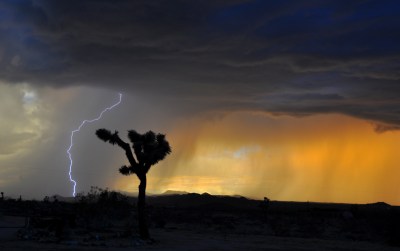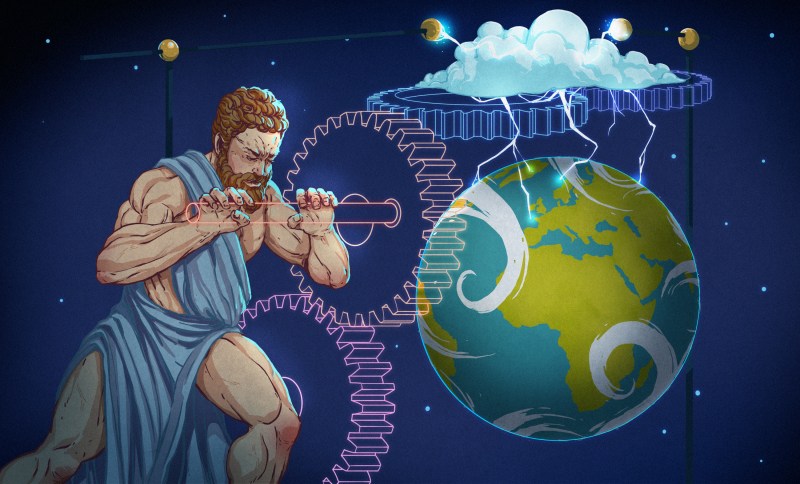Along with many other natural phenomena, lightning is probably familiar to most. Between its intense noise and visuals, there is also very little disagreement that getting hit by a lightning strike is a bad thing, regardless of whether you’re a fleshy human, moisture-filled plant, or conductive machine. So it’s more than a little bit strange that the underlying cause of lightning, and what makes certain clouds produce these intense voltages along ionized air molecules, is still an open scientific question.
Many of us have probably learned at some point the most popular theory about how lightning forms, namely that lightning is caused by ice particles in clouds. These ice particles interact to build up a charge, much like in a capacitor. The only issue with this theory is that this process alone will not build up a potential large enough to ionize the air between said clouds and the ground and cause the lightning strike, leaving this theory in tatters.
A recent study, using data from Earth-based radio telescopes, may now have provided fascinating details on lightning formation, and how the charge may build up sufficiently to make us Earth-based critters scurry away to safety when dark clouds draw near.
Follow The Streamers

The most succinct way to summarize lightning is probably as a ‘really big spark’. Like any spark, this requires the build up of a potential to the point where the dielectric medium between the potential and a target breaks down. In the case of air as the dielectric medium, this involves the breaking down of air molecules, at roughly 2 MV/m, into electrically conductive plasma by stripping electrons from atoms. Once there is a plasma track, the rest of the charge is free to dump; during the subsequent discharge in a lightning strike, in the order of a gigajoule of energy is transferred.
To build up this charge, the triboelectric effect is deemed to be primarily involved. While heavier graupel (soft hail) remains mostly stationary inside the cloud, updrafts carry lighter ice crystals and super-cooled droplets between the graupel, resulting in the physical interaction that underlies the triboelectric charging effect.
As noted earlier, the resulting charge that builds up inside a thundercloud in this manner is not sufficient by itself to cause a lightning stream with the ground. This has for ages left open the question of what initiates the build-up of such a breakdown. One theory here is that of relativistic runaway electron avalanche (RREA), with an extensive explanation provided by Gurevich et al. (2005) in Physics Today (PDF).

The short version of this theory is that relativistic electrons from outside the atmosphere are the trigger for the sudden initiation charge of a lightning strike event. As the electrons that exist inside the cloud at that point are thermal (‘slow’) electrons, this would provide the impulse that would set off the formation of self-replicating streamers.
Streamers are the clearest observable sign of a lightning strike in progress: they are ionization events caused by the breakdown of the air molecules into a plasma. This does not only provide an electrical path for the stored charge, but also causes the release of electromagnetic radiation. If there are enough free electrons to continue the further ionization of the surrounding air, the streamer will propagate, with ultimately a leader surge forming.
It is this leader that forms the clear bright line in a lightning strike, preceded and surrounded by streamers.
Lit Up Like A Christmas Tree

If there’s one property of clouds that makes them a bother when it comes to observing the formation of lightning, it is that they are opaque to most types of observations. Whether we send up balloons with cameras, fly airplanes around or through thunderstorms, the problem remains that we cannot see a lot of what’s happening inside the clouds. The main exception to this is in the RF spectrum, which is where thunderstorms are exceptionally visible.
As mentioned by Gurevich et al., during thunderstorms RF events called narrow bipolar pulses of about 5 μs are common, along with X-ray bursts that can last up to a minute. These events are in addition to the release of gamma ray bursts (0.05 MeV – 10 MeV) that occur at an altitude of between 500 and 600 km. For Gurevich et al. these highly energetic events were highly indicative of relativistic electrons playing a role in lightning ignition.
Due to the aforementioned difficulties with actually seeing inside clouds, all of this was based on observations in mostly the radio spectrum, until a 2018 attempt by the Dutch Low-Frequency Array (LOFAR) radio telescope was it possible to image the formation of a lightning strike in 3D space. As implied by the name, LOFAR consists out of an array of distributed radio telescopes, with a core in the Netherlands and further distributed throughout Europe.
Using the Dutch part of the array, it was possible to use the time-delay from the observed RF events during a lightning storm at the different parts of the array to form a picture of the events as they developed. This enabled Sterpka et al. to create the following hypothesis based on these observations.

What they found is that, rather than an external trigger, the process starts (a) with a single positive streamer (b), which creates the initial VHF field (c). The middle panel describes an avalanche cascade of streamers, with each streamer producing more streamers, creating the ever stronger VHF field, which the LOFAR equipment captured. Finally, the right panel shows the formation of a leader (h).
Sterpke et al. propose that the narrow bipolar pulses that are observed at the initialization event are due to the breakdown of virgin air or similar, which forms a precondition for the lightning initiation. Perhaps the most interesting finding is that a system of streamers appear to have very different properties from an individual streamer, which might play a significant role in the formation of lightning.
Flashy Science

Interestingly, lightning is a phenomenon that doesn’t just affect the present, but also the past. When lightning strikes the ground, it can cause the formation of fulgurites (from Latin fulgur, meaning ‘lightning’). This is a type of mineraloid formed by the fusion of mineral grains, which follows the shape of the lightning strike which was responsible for its formation. Within a lightning channel, temperatures can exceed 30,000 Kelvin.
More than just a curiosity, fulgurites are an invaluable paleoenvironmental indicator, giving us an idea of what the climate including lightning frequency was like in a region. This is part of the field of paleolightning. Along with evidence of the role lightning may have played during the formation of life on Earth (e.g. the Miller-Urey experiment), lightning plays a role in nitrogen fixation.
Another interesting, more recent finding came from during the SARS-CoV-2 pandemic and the shutdowns of 2020. Namely that of the correlation between pollution and the frequency of lightning. This would presumably be due to anthropogenic pollution providing e.g. fine dust particles which form a nucleus for ice formation inside clouds.
Hopefully over the coming years we’ll find out more details about what makes lightning work, as well as what affects the formation of the cumulonimbus clouds. With more refined radio telescope arrays like the Square Kilometre Array (SKA) coming online, it might be that they could give us more glimpses at this phenomenon that has mesmerized human cultures since the dawn of time.
While being an obvious risk to life and property, lightning remains one of the primal forces that shaped the biosphere of the Earth, and continues to do so to this day. Even as we admire its beauty from a (hopefully) safe distance, it might behoove us to acknowledge how little we truly know about it and the high-energy physics that underlie it.
















When I and two friends saw a ball of lightning entering the house through the window, then BOUNCING on the stairs, passing between us, to finally explode when reaching the (de-facto grounded) heating pipe, we were … stunned. The weather was very dry and hot, and when the storm came, there was no rain.
There is still no explanation in view for this phenomenon, and many scientists still don´t admit such a phenomenon exists.
Aliens
tripping balls lightning
that had to be cool.
Ω I
Your story left me amped
Truly shocking tale, you could feel the electricity in the room
I need to go ground myself…
I hear when the human body is faced with so much potential, it offers little resistance.
Reminds me of a guy who survived two lightning strikes… first name was Rod.
https://www.theregister.com/2015/06/27/lightning_rod/
“in the order of a gigajoule of energy is transferred“ I believe the energy of single lightning strikes is more usually expressed in Watts.
Energy is in Joules.
Watts is an expression of power, that is energy per time unit.
If you want to believe something else, then you may consider to join the flat-earthers.
Was a wilowisp.
Do you even D&D?
Don’t accept conventional explanations for lightning either. Bet the people presenting them think the earth is spherical. Fools!
Duh… it’s clearly a dodecahedron!
Did it knock the Cannabis out of your hands?
I’m not sure if it’s 100% accepted, but lucky spectroscopic analysis of ball lightning indicated that it was silicon vapor from silicon-rich soil burning back to silica. see e.g. “Burning Soil Fuels Ball Lightning” from physicsworld
“… soil burning back to silica …”
A bit tricky to understand how it could form inside a flying aircraft then!
(Mind you, it is even trickier to describe how it could form inside the Faraday Cage of the fuselage).
https://www.nature.com/articles/224895a0 describes a typical in-flight event.
“(Mind you, it is even trickier to describe how it could form inside the Faraday Cage of the fuselage).”
It’s not RF, it’s actual charge moving. Charge can, and does, happily build up on planes, and while a hollow conductor shields its interior, planes aren’t hollow conductors.
Note the description: emerged from the **pilot’s cabin**. Where, y’know, there’s a big ol’ non-conductive pane of glass.
The reason it’s so hard to describe ball lightning is that it’s probably not just one “thing.” You can generate “ball lightning” (as in, a bit of hot plasma) via a ton of different ways. Weird crap happens in megavolt/meter fields.
Right on to both ideas. For years there were no good photographs of either the terrestrial or aero type. I’m not free there is a theory f for how the ground-based ones are initiated by silicon ore sounds like a dirty semicircular. An airplane, where they have had multiple witnesses for years and now photos might be thought of a capacitor full of stuff and people, maybe a family of Farads….
Could it be a macro form of skyrmions…?
http://www.sciencedaily.com/releases/2013/06/130602203955.htm
The header image gives it away. It’s obviously that giant guy that’s turning the crank. ;)
+500 Quatloo…
I’ve been saying for 50 years that fusion will be mastered when they can make stable ball lightning.
So for now they are still blowing smoke rings and fusion is still 50 years away.
So like, not to be rude or anything like that at all, but
1) Im very curious to hear how you would imagine this working? because i see a few issues, based on what little we do know these things are not sustainable, they go trough solid objects & we dont know how they are created? Since we cant create any to test things with we also have no idea at all if these ‘objects’ could even be caught in a magnetic field or anything like that either.
2) Meanwhile there was recently a step forward at the JET lab (Joint European Torus – currently the biggest fusion research project) and there was no smoke rings being blown at all, they pretty much just went “look we got some better results compared to the past, wich is great, but we’re still decades off from this being any sort of usable”
I wonder if much of the charge that builds up in the clouds could be related to the phenomenon that causes the “Kelvin’s Thunderstorm”. It seems to me that if 10-20kV can be built up with a small amount of moving water, that the huge volumes present in a thundercloud should do likewise. I could be all wet, of course.
I meant to include this link to a Veritasium video on the subject:
https://www.youtube.com/watch?v=rv4MjaF_wow
When lightening is discussed, I always like to share the video I was most impressed with to this date, explaining, well, not how it works, but what it does, and comes from Pecos Hank, great footage. https://www.youtube.com/watch?v=JXhif3E3l2s
lightning. erwhhpfrr.
Generation of Runaway Electrons Induced by Cosmic-Ray Muons in Thunderstorm Electric Fields
From memory and should be mentioned: inter-cloud, intra-cloud, ground-to-cloud, ground-to-cloud and ball lightning are are observed types of lightning and each has distinct characteristics and effects.